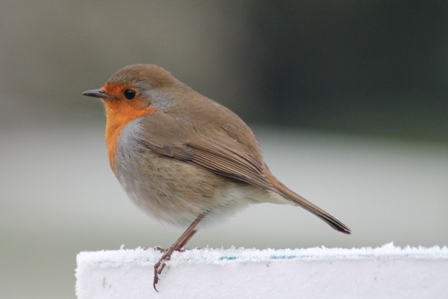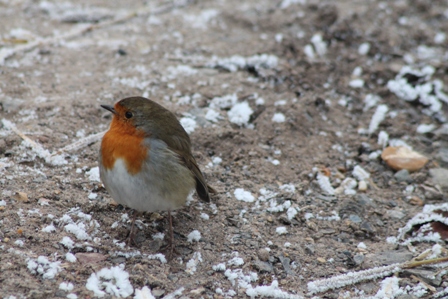Robin (Erithacus rubecula)
Highly strung and hot-tempered, the Robin is one of Europe’s most famously territorial birds. The red (actually orange) breast is a permanent signal to other birds to keep their distance from owner-occupiers, and intruders that breach the defended borders of territories are asking for trouble: battles over land can be tense and violent, very occasionally resulting in death. In the spring and summer it is mostly males that snarl and skirmish, but females join in in the autumn and winter. And a Robin’s ire may not only be expressed towards rivals. A Robin may become bothered by other small skulking species such as Dunnocks, too, and even by mice on occasions.
So why do Robins guard their patch so jealously? It is at least partly to do with their feeding method. The Robin is a professional exponent of the art of Perch and Pounce, habitually sitting still on a low, often shady perch near the woodland floor, waiting for insects or worms to come into view below it. If they do, the Robin flits down to catch them; if they don’t it will go hungry, or adopt another method such as hopping along the ground. And what a Robin needs for Perch and Pounce to be effective is privacy. If silence prevails the small creatures of the ground layer will show themselves, but if another Robin or passing bird intrudes into the feeding arena it might cause a good meal to scuttle back into the leaf-litter, scratching its name from the Robin’s menu – and that simply won’t do. Hence the territory-holder’s need to keep its boundaries intact.
In the main a territory is defended by song. The Robin is one of the few birds that sings almost throughout the year, with a lull only during the moult in July and August. It is a shrill, wistful effort with a deceptively relaxed tone. Usually there are pauses between each song phrase, and each song is different from the last, as if the bird was answering questions from an inaudible interviewer. When birds are fired up, however, they alternate their phrases, one quickly following on from the other, as if the competitors were hitting shots in a rally; or one bird may overlap its rival’s phrase. These song-duels may last for hours, and signify the last attempts at a negotiated settlement in a contest between two birds.
Vocal rivalry then develops into visual display. The opponents face each other and show off their red breasts to maximum effect. On the ground they will puff themselves up and point to the sky, while on a perch they will lean forward if the rival is below them or lean back if the rival is above. Most visual encounters prompt a quick withdrawal by a rival, but occasionally these lead to fast and vicious fight, with much kicking and pecking directed at the other bird’s face and eyes.
In the middle or late winter a quite different song display begins to be heard. A male Robin no longer sings from medium height on a half-concealed perch, as is its norm. Instead it operates from higher up, in a more conspicuous position, and sending forth an allegedly more cheery song. This is the mate attraction song, and aims to advertise the bird to local females. The latter indicate interest by intruding on the territory, initially to the usual hostility from the male. But after a few attempts the territory holder gets the message, and the two birds engage in the so-called Song and Following ceremony, the male singing and the female chasing. The pair bond is formed, the male resumes its usual song, and it may then be several months before nest-building begins.
Robins build their cup of dead leaves, moss and grass in a concealed site low to the ground, or on it. A hollow in a bank is a favoured site, as are the roots of trees. In the west of Europe where Robins are common garden birds they often use unusual sites, such as shelves in greenhouses, coat pockets of flower pots.


